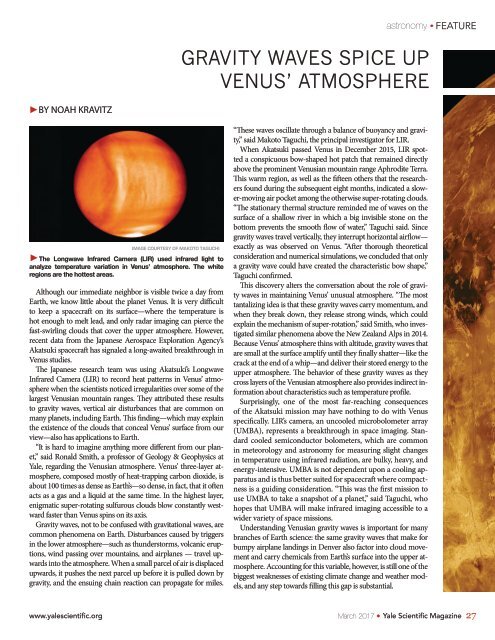YSM Issue 90.2
Create successful ePaper yourself
Turn your PDF publications into a flip-book with our unique Google optimized e-Paper software.
astronomy<br />
FEATURE<br />
GRAVITY WAVES SPICE UP<br />
VENUS’ ATMOSPHERE<br />
►BY NOAH KRAVITZ<br />
IMAGE COURTESY OF MAKOTO TAGUCHI<br />
►The Longwave Infrared Camera (LIR) used infrared light to<br />
analyze temperature variation in Venus’ atmosphere. The white<br />
regions are the hottest areas.<br />
Although our immediate neighbor is visible twice a day from<br />
Earth, we know little about the planet Venus. It is very difficult<br />
to keep a spacecraft on its surface—where the temperature is<br />
hot enough to melt lead, and only radar imaging can pierce the<br />
fast-swirling clouds that cover the upper atmosphere. However,<br />
recent data from the Japanese Aerospace Exploration Agency’s<br />
Akatsuki spacecraft has signaled a long-awaited breakthrough in<br />
Venus studies.<br />
The Japanese research team was using Akatsuki’s Longwave<br />
Infrared Camera (LIR) to record heat patterns in Venus’ atmosphere<br />
when the scientists noticed irregularities over some of the<br />
largest Venusian mountain ranges. They attributed these results<br />
to gravity waves, vertical air disturbances that are common on<br />
many planets, including Earth. This finding—which may explain<br />
the existence of the clouds that conceal Venus’ surface from our<br />
view—also has applications to Earth.<br />
“It is hard to imagine anything more different from our planet,”<br />
said Ronald Smith, a professor of Geology & Geophysics at<br />
Yale, regarding the Venusian atmosphere. Venus’ three-layer atmosphere,<br />
composed mostly of heat-trapping carbon dioxide, is<br />
about 100 times as dense as Earth’s—so dense, in fact, that it often<br />
acts as a gas and a liquid at the same time. In the highest layer,<br />
enigmatic super-rotating sulfurous clouds blow constantly westward<br />
faster than Venus spins on its axis.<br />
Gravity waves, not to be confused with gravitational waves, are<br />
common phenomena on Earth. Disturbances caused by triggers<br />
in the lower atmosphere—such as thunderstorms, volcanic eruptions,<br />
wind passing over mountains, and airplanes — travel upwards<br />
into the atmosphere. When a small parcel of air is displaced<br />
upwards, it pushes the next parcel up before it is pulled down by<br />
gravity, and the ensuing chain reaction can propagate for miles.<br />
“These waves oscillate through a balance of buoyancy and gravity,”<br />
said Makoto Taguchi, the principal investigator for LIR.<br />
When Akatsuki passed Venus in December 2015, LIR spotted<br />
a conspicuous bow-shaped hot patch that remained directly<br />
above the prominent Venusian mountain range Aphrodite Terra.<br />
This warm region, as well as the fifteen others that the researchers<br />
found during the subsequent eight months, indicated a slower-moving<br />
air pocket among the otherwise super-rotating clouds.<br />
“The stationary thermal structure reminded me of waves on the<br />
surface of a shallow river in which a big invisible stone on the<br />
bottom prevents the smooth flow of water,” Taguchi said. Since<br />
gravity waves travel vertically, they interrupt horizontal airflow—<br />
exactly as was observed on Venus. “After thorough theoretical<br />
consideration and numerical simulations, we concluded that only<br />
a gravity wave could have created the characteristic bow shape,”<br />
Taguchi confirmed.<br />
This discovery alters the conversation about the role of gravity<br />
waves in maintaining Venus’ unusual atmosphere. “The most<br />
tantalizing idea is that these gravity waves carry momentum, and<br />
when they break down, they release strong winds, which could<br />
explain the mechanism of super-rotation,” said Smith, who investigated<br />
similar phenomena above the New Zealand Alps in 2014.<br />
Because Venus’ atmosphere thins with altitude, gravity waves that<br />
are small at the surface amplify until they finally shatter—like the<br />
crack at the end of a whip—and deliver their stored energy to the<br />
upper atmosphere. The behavior of these gravity waves as they<br />
cross layers of the Venusian atmosphere also provides indirect information<br />
about characteristics such as temperature profile.<br />
Surprisingly, one of the most far-reaching consequences<br />
of the Akatsuki mission may have nothing to do with Venus<br />
specifically. LIR’s camera, an uncooled microbolometer array<br />
(UMBA), represents a breakthrough in space imaging. Standard<br />
cooled semiconductor bolometers, which are common<br />
in meteorology and astronomy for measuring slight changes<br />
in temperature using infrared radiation, are bulky, heavy, and<br />
energy-intensive. UMBA is not dependent upon a cooling apparatus<br />
and is thus better suited for spacecraft where compactness<br />
is a guiding consideration. “This was the first mission to<br />
use UMBA to take a snapshot of a planet,” said Taguchi, who<br />
hopes that UMBA will make infrared imaging accessible to a<br />
wider variety of space missions.<br />
Understanding Venusian gravity waves is important for many<br />
branches of Earth science: the same gravity waves that make for<br />
bumpy airplane landings in Denver also factor into cloud movement<br />
and carry chemicals from Earth’s surface into the upper atmosphere.<br />
Accounting for this variable, however, is still one of the<br />
biggest weaknesses of existing climate change and weather models,<br />
and any step towards filling this gap is substantial.<br />
www.yalescientific.org<br />
March 2017<br />
Yale Scientific Magazine<br />
27


















